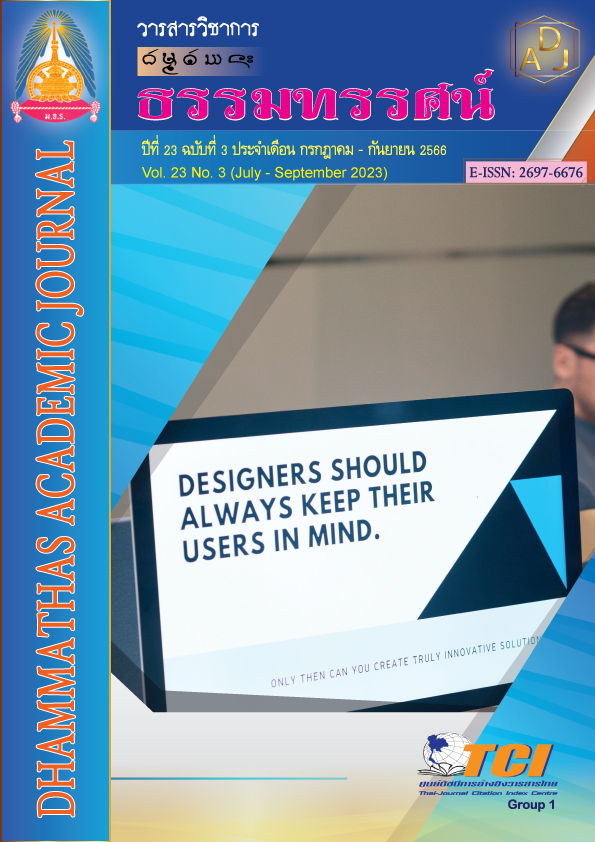The Effectiveness of Meditation after Praying Practice on Blood Sugar Levels of Patients with Type 2 Diabetes Mellitus, Don Bom Sub district Health Prompting Hospital, Muang Kao Sub district, Muang District, Khon Kaen Province
Main Article Content
Abstract
The purpose of this research are to study the effectiveness of meditation after prayer on blood sugar levels in patients with type 2 diabetes mellitus, to compare the accumulated sugar levels in the blood of patients who meditate after prayer and those who do not meditate after prayer and to compare appropriate self-care behaviors after regular meditation practice after prayer. This is quasi-experimental research with divided into 22 patients as an experimental group. The activities consisted of a review educating and practicing meditation after prayer to the experimental group, with a duration of 12 weeks, and The comparative analysis of the mean scores within the groups by the paired sample t-test, compared with the mean scores between the groups by the independent sample t-test, with a statistical significance of 0.05 and 95% CI.
The research result finds that: Purpose 2) the experimental HbA1C among the were statistically better and better than the comparison group (p-value < 0.05) and the experimental Hb A1C tended to decrease drop 8.67 % to 7.47. Purpose 3) The experimental group's mean scores on self-management knowledge and holistic healthcare practices of patients were higher than before and statistically significantly higher than the comparison group (p-value < 0.001).
Article Details

This work is licensed under a Creative Commons Attribution-NonCommercial-NoDerivatives 4.0 International License.
เพื่อให้เป็นไปตามกฎหมายลิขสิทธิ์ ผู้นิพนธ์ทุกท่านต้องลงลายมือชื่อในแบบฟอร์มใบมอบลิขสิทธิ์บทความ ให้แก่วารสารฯ พร้อมกับบทความต้นฉบับที่ได้แก้ไขครั้งสุดท้าย นอกจากนี้ ผู้นิพนธ์ทุกท่านต้องยืนยันว่าบทความ ต้นฉบับที่ส่งมาตีพิมพ์นั้น ได้ส่งมาตีพิมพ์เฉพาะในวารสาร วิชาการธรรม ทรรศน์ เพียงแห่งเดียวเท่านั้น หากมีการใช้ ภาพหรือตารางของผู้นิพนธ์อื่นที่ปรากฏในสิ่งตีพิมพ์อื่นมาแล้ว ผู้นิพนธ์ต้องขออนุญาตเจ้าของลิขสิทธิ์ก่อน พร้อมทั้ง แสดงหนังสือที่ได้รับการยินยอมต่อบรรณาธิการ ก่อนที่บทความจะได้รับการตีพิมพ์References
กมลพร สิริคุตจตุพร, วิราพรรณ วิโรจน์รัตน และนารีรัตน์ จิตรมนตรี. (2560). ปัจจัยทำนายพฤติกรรมการจัดการตนเองของผู้สูงอายุโรคเบาหวานชนิดที่ 2. วารสารสภาการพยาบาล , 32(1), 81-93.
กรมควบคุมโรค กระทรวงสาธารณสุข. (2563). คู่มือการดูแลตัวเองเบื้องต้นเรื่องเบาหวาน. กรุงเทพฯ: องค์การสงเคราะห์ทหารผ่านศึก.
กรุงเทพธุรกิจ. (2565). สถานการณ์เบาหวานยังคงต้องจับตา. เข้าถึงได้จาก https://www.bangkokbiznews.com/social/916378
นฤมล สินสุพรรณ. (2561). การดูแลสุขภาพแบบองค์รวมวิถีไทยเชิงพุทธ. เอกสารเสริมการสอนนักศึกษาสาธารณสุขศาสตรมหาบัณฑิต สาขาวิชาภาวะผู้นำและนวัตกรรมการจัดการสุขภาพ. ขอนแก่น: วิทยาลัยบัณฑิตเอเชีย.
ประกาศคณะกรรมการหลักประกันสุขภาพแห่งชาติ เรื่อง หลักเกณฑ์การดำเนินงานและการบริหารจัดการกองทุนหลักประกันสุขภาพแห่งชาติสำหรับผู้มีสิทธิหลักประกันสุขภาพแห่งชาติ ปีงบประมาณ พ.ศ. 2565 และหลักเกณฑ์ วิธีการ และเงื่อนไขการรับค่าใช้จ่ายเพื่อบริการสาธารณสุขของหน่วยบริการ พ.ศ. 2564
วรัญญากรณ์ โนใจ. (2561). ผลของการปฏิบัติสมาธิบำบัดเพื่อการเยียวยาแบบ SKT ต่อระดับน้ำตาลในเลือดของกลุ่มเสี่ยงโรคเบาหวาน. พะเยา: วิทยาลัยพยาบาลบรมราชชนนีพะเยา.
วิริยังค์ สิรินธโร. (2540). หลักสูตรครูสมาธิ เล่ม 1. กรุงเทพฯ: พันนาบรรจุพันธ์.
Benson, H. (1967). The Relaxation Response. Retrieved from http://202.44.33.100/samathi/branch/7/branch.php
Ryan, P. & Sawin, K. J. (2009). The individual and family self-management Theory: background and perspectives on context, process, and outcomes. Nursing Outlook, 57(4), 217-225.
The International Diabetes Federation. (2017). About diabetes What is diabetes. Retrieved from https://idf.org/events/idf-congress/

